Pros and cons
The advantages of whitewashing the ceiling:
- Profitability... When self-applied, the finished coating will cost about 40-50 rubles per 1 square meter.
- Environmental friendliness... Most often, chalk or lime are used to achieve white color - natural minerals.
- Simplicity... Unlike the same staining, anyone can whiten.
- Fungus protection... Whitewashing is distinguished by bactericidal properties, does not allow mold to grow.
- Matte snow-white texture... Relevant in recent years.
- Vapor permeability... The surface of the ceiling "breathes" - another blow to the fungus.
Unfortunately, whitewashing the ceiling also has disadvantages:
- Fragility... White color in living rooms (bedroom, living room) lasts a maximum of 3-4 years, in kitchens, bathrooms and even less - 12-24 months.
- The need for painstaking preparation... Before whitewashing the ceiling, it must be thoroughly cleaned, leveled and prime... Otherwise, painting will accentuate surface imperfections.
More accurate pros and cons depend on what composition is used to whitewash the white ceiling. We will talk about the possible options, their features in the section "What can be used to whiten?".
How to prepare the ceiling?
Like any finishing work, whitewashing the ceiling begins with preparation. First of all, remove all things from the room. If bulky items (for example, a wardrobe or a sofa) could not be taken out, cover them tightly with foil.
Important! The process of removing the old coating and applying a new one is quite dirty, put on clothes that you do not mind, do not forget to protect your eyes with glasses, your hair with a scarf or any headdress.
Removing the old layer
Application on existing coatings is not recommended: old whitewash must be removed. For this it will come in handy:
- a bucket of warm water (clean or soapy);
- rag sponge; spatula;
- flat basin, tray or pallet.
Divide the area of the room into small squares mentally, act gradually: well soak the coating on the site, remove with a spatula, substituting the tray under the crumbling whitewash (this technique will save you from washing the floor). You should act quickly - if the water dries up, you will have to process the place again.
Advice! Use a garden air sprayer for more efficient and faster soaking.
It is quite easy to wash off the chalky whitewash, but if ordinary water does not take the coating, most likely you are dealing with lime whitewash. To remove it, dissolve 2 tablespoons of baking soda in 10 liters of warm water, 3 tablespoons of vinegar.
Further, everything is according to the described technology - moisturize and scrape off. At the end of the dismantling stage, you will need to perform wet cleaning: you can wash off the remnants with a damp cloth or brush.
Important! If the old whitewash is strong enough, you can leave it. But the fresh layer must be made of the same material: chalk over chalk, lime over lime. To understand what the ceiling was whitewashed, it is enough to run a wet finger over it. Are there any marks on your hand? It's chalk.Not? Lime.
Rough preparation
Includes plastering (if necessary), filling cracks and irregularities, leveling, priming. The process depends on the specific case and type of surface:
- Concrete base... It may be necessary to seal the tile joints with a painting serpyanka, general leveling with a finishing putty, sanding, priming.
- Drywall... Preparing drywall is a little easier: just cover the seams, go through the thinnest layer of putty to level the color and remove dark spots, prime.
When the primer is completely dry (usually it takes 24 hours), go directly to whitewashing the ceiling with our own hands.
What can you whiten?
There are 3 most popular solutions for whitewashing: they have their own characteristics, advantages and disadvantages.
a piece of chalk
Natural dye that gives natural whiteness. Chalk absolutely does not smell, does not cause allergies, and is breathable. In addition, this material the cheapest of the presented.
Of the minuses - the treated surface crumbles (dust), the fear of water excludes the possibility of using it in wet rooms (bathroom, kitchen). In addition, she will not be able to whitewash the walls along with the ceiling, since the chalk is smeared when touched.
Advice! To make the chalk white stronger and whiter, prepare a special solution. For 5 liters of hot water, take 3 kg of chalk powder, 15 g of blue and 60 g of wood glue (responsible for high viscosity). Mix everything thoroughly and you can start working!
If the mixture drips off the knife, the amount of chalk can be added in small amounts, stirring thoroughly after each portion.
Lime
Whitewashing the ceiling with lime mortar is a little more expensive than chalk. In addition, after complete drying, lime begins to take moisture from the air, thereby lowering the humidity level in the room. The last drawback is the hue, which is more off-white than boiling. But it can be fixed!
But the slaked lime does not get dirty, does not crumble, protects the surface from mold.
To improve the properties of the fluff, it is mixed with special additives.
- Salt... The pre-added salt will help increase the strength of the whitewash applied.
- Carpentry glue... Are you going to apply lime composition not only to the ceiling, but also to the walls? Add glue - the treated surface will not smear with it.
- Soap... A little laundry soap is responsible for the elasticity: no more streaks or streaks from the brush.
Water based paint
You cannot make water-based paint on your own - you need to buy it ready-made. This fact is both a plus (no need to spend time and effort on kneading) and a minus (ready-made compositions are much more expensive). But the water emulsion lies smoother, does not fade and does not turn yellow, is not afraid of mechanical stress.
Check out the main errors that occur when painting.
What tools do you need?
Before whitening the ceiling, first prepare everything you need:
- A bucket in which we will knead the solution.
- Construction mixer (drill with attachment).
- Natural brush, brush, roller with a ditch, spray gun or vacuum cleaner - depending on what you plan to whitewash.
How to whiten correctly?
When the mixture is selected and ready, a suitable tool is found, you can start whitewashing.
Step-by-step instruction
Before starting work, it is important to know some rules:
- Pre-wet the base if you have chosen a lime fluff for work.
- With a brush with natural bristles, carefully paint over hard-to-reach places: corners, joints.
- Apply the first coat perpendicular to the window wall.
- Wait for the first layer to dry (5-6 hours).
- Lay the second layer perpendicular to the first (parallel to the window).
Important! Come with each new stroke on the previous one by a few centimeters - this way you can avoid "bald patches" (unpainted places).
So that your work is not in vain, do not open the windows and protect the freshly painted surface from drafts until it dries completely.As with the wallpaper, the wind walking around the apartment is destructive for the whitewash.
Water-based paint is applied according to the same principle, but sometimes it can behave unpredictably: it can go in spots, stripes. If this happens, sand the ceiling in a circular motion with a fine abrasive, the streaks should disappear.
Video for beginners
See an unusual recipe for high-quality chalk white with detailed instructions:
Detailed description of the preparation of the lime composition:
You will learn the secrets of easy and quick ceiling painting from the third video instruction:
Although modern masters consider whitewashing an outdated material for decoration, it still has its own connoisseurs who like the economy, environmental friendliness of whitewash and their ease of use. Whitewashing is used not only for ceiling decoration, it is also used to paint the walls inside and outside the house.


 10 practical tips for arranging a small kitchen in the country
10 practical tips for arranging a small kitchen in the country
 12 simple ideas for a small garden that will make it visually spacious
12 simple ideas for a small garden that will make it visually spacious
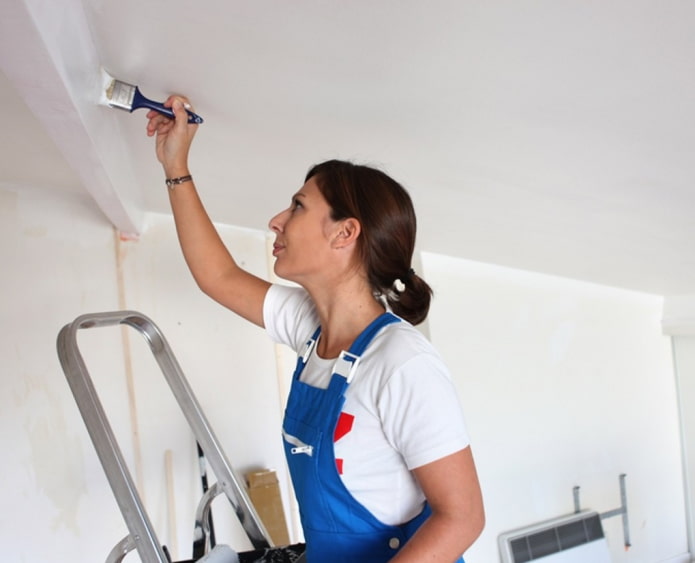
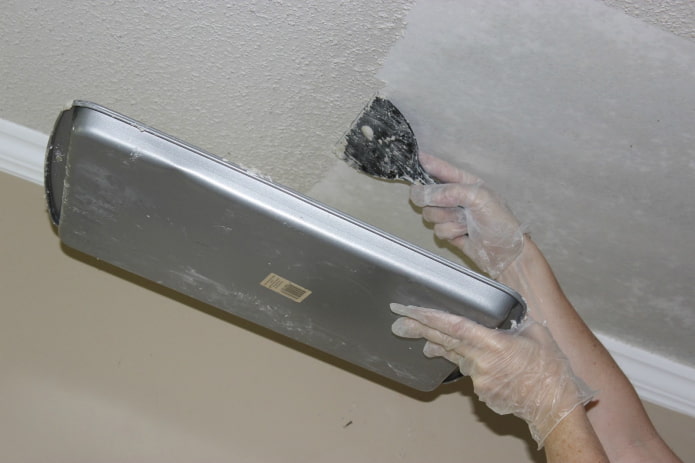
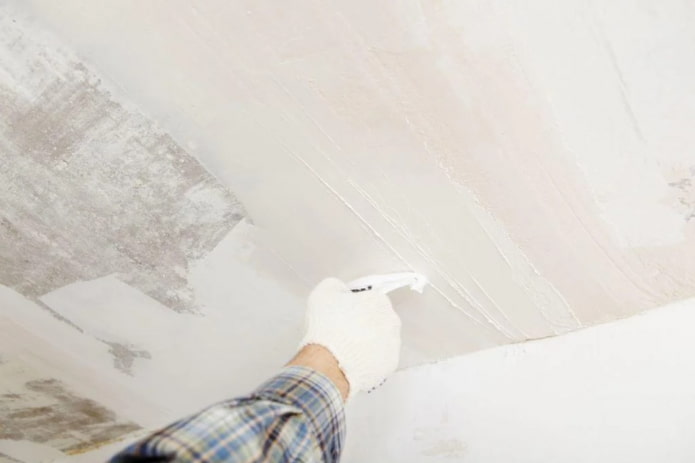
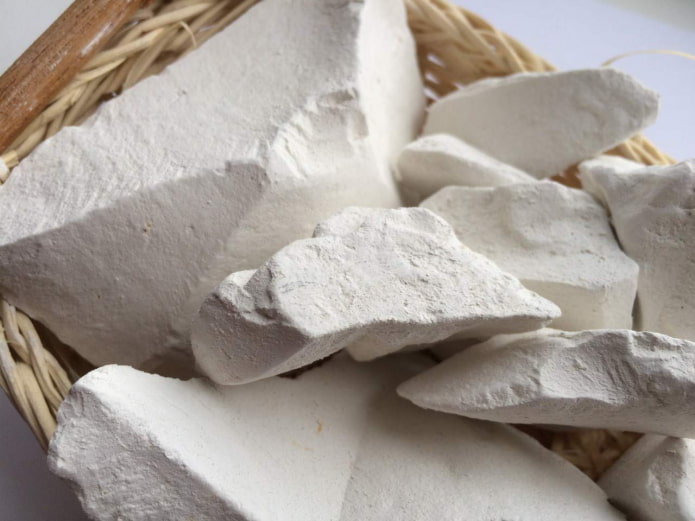
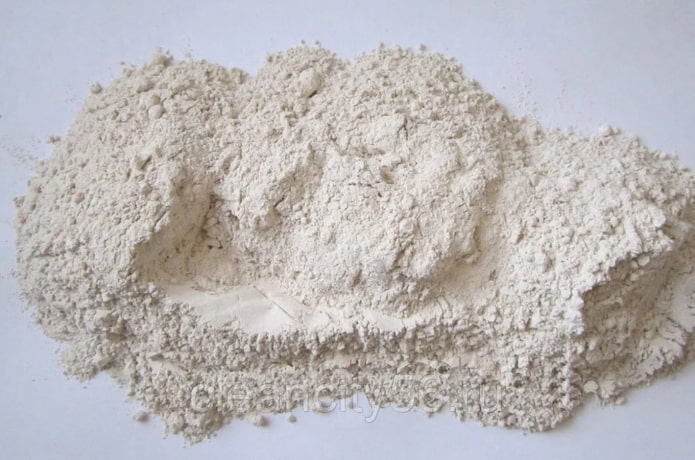
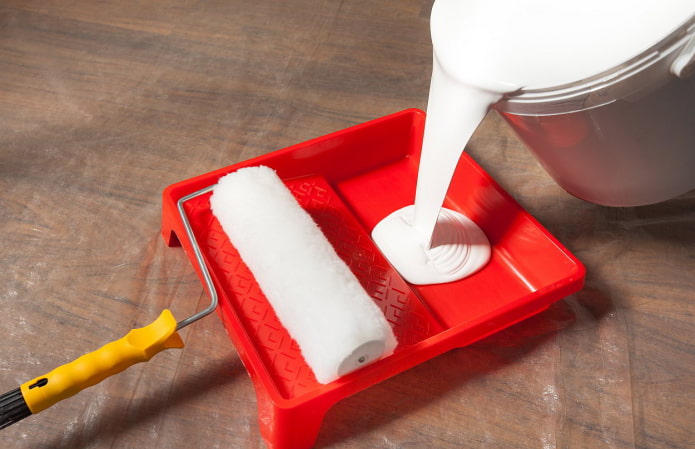
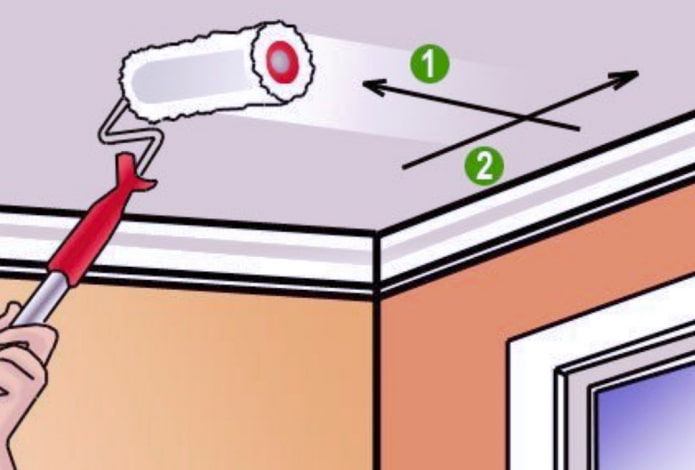
 What is better not to do it yourself during the repair?
What is better not to do it yourself during the repair? Bloated linoleum: how to fix it without disassembly
Bloated linoleum: how to fix it without disassembly The worst decisions in apartment renovation
The worst decisions in apartment renovation  Installation of ceiling tiles: choice of materials, preparation, order of work
Installation of ceiling tiles: choice of materials, preparation, order of work How to glue a ceiling plinth to a stretch ceiling?
How to glue a ceiling plinth to a stretch ceiling? Ceiling plinth for stretch ceiling: types, recommendations for selection
Ceiling plinth for stretch ceiling: types, recommendations for selection